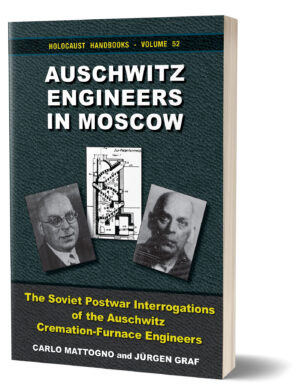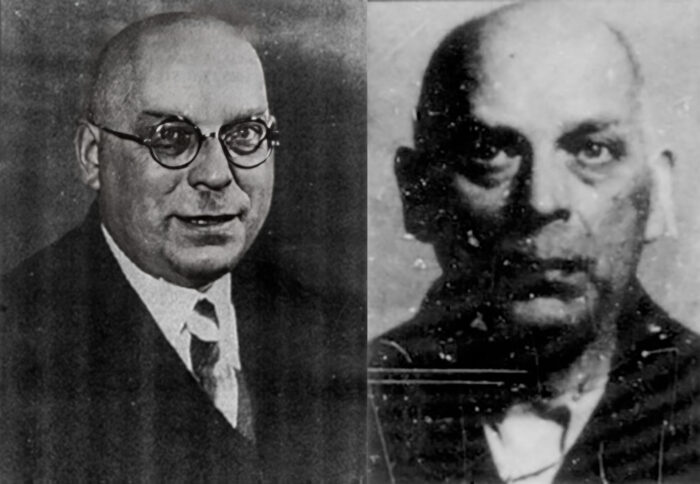Auschwitz Engineers in Moscow
An Introduction
“Habent sua fata libelli” – Books have their own destiny. This adage applies not least to the present book.
It all began in October 1993, on the fourth of that month, when the German news magazine Der Spiegel published an article with the lurid title “The Engineers of Death” (“Die Ingenieure des Todes”). Based on the British-Jewish researcher Gerald Fleming, who had conducted research in Moscow archives, the Hamburg news magazine published excerpts from the interrogation records of three engineers from the Erfurt engineering company Topf & Söhne and Sons, who had been arrested by the Soviet occupying forces in March 1946. They were Kurt Prüfer, chief engineer for cremation furnaces and heating systems, Karl Schultze, chief engineer for ventilation systems, and Gustav Braun, production manager at Topf. (In addition to Prüfer, Schultze and Braun, the Soviets also caught a fourth engineer, Fritz Sander, chief engineer at Topf & Sons).
 All four defendants were accused of participating in an outrageous mass murder. A huge number of people, it was said, had been murdered in gas chambers at Auschwitz, and the bodies of those killed had been burned in cremation furnaces. Through their involvement in the construction and installation of the cremation furnaces and in setting up the ventilation equipment, the Topf engineers were accused of having actively aided and abetted this mass murder.
All four defendants were accused of participating in an outrageous mass murder. A huge number of people, it was said, had been murdered in gas chambers at Auschwitz, and the bodies of those killed had been burned in cremation furnaces. Through their involvement in the construction and installation of the cremation furnaces and in setting up the ventilation equipment, the Topf engineers were accused of having actively aided and abetted this mass murder.
However, the prosecutors were unable to provide any documentary or material evidence for the claimed gas-chamber genocide. In reality, the crematoria at Auschwitz Main Camp and Auschwitz Birkenau had been built for hygienic reasons. The death rates in those camps had been terrifyingly high, mainly due to recurrent epidemics of typhus in the camp, and the capacity of the Main Camp’s crematorium (Krema I) proved to be insufficient. Initially, the corpses that could not be cremated were simply buried, but because this was associated with considerable danger due to the high groundwater level near Auschwitz, it was decided to build four more crematoria in the Auschwitz Birkenau Camp. The Topf Company was commissioned to provide the furnaces for these facilities.
The engineers in question had not extinguished a single human life through their work. Quite to the contrary, they had certainly saved thousands of people, because without these crematoria, the death toll at Auschwitz and Birkenau undoubtedly would have been even higher. Under normal circumstances, no one would have thought of accusing these men of a crime, but in 1946, the circumstances were not normal. The nascent “Holocaust” story was in urgent need of cementing, and in the absence of documentary or forensic evidence, this could only be achieved through witness statements and perpetrator confessions.
According to Der Spiegel, the spontaneity and accuracy of these confessions is beyond the shadow of a doubt:
“It is unlikely that the confessions were made under pressure. Already having been incriminated by written documents, they may have hoped to influence the verdict with their frank confessions.”
The leading German disinformation media outlet did not deign to tell its readers what “written documents” had been used to “incriminate” the engineers.
While Fritz Sander died of heart failure just three weeks after his arrest, his three colleagues were each sentenced to 25 years of forced labor in 1948. Kurt Prüfer did not survive the Gulag, but Braun and Schultze were released in 1956 thanks to an amnesty. We have no information about their further fate.
Since the interrogation transcripts are of extraordinary historical interest, Carlo Mattogno and I made an effort to locate these documents at the end of 1995, when we were conducting research in Moscow archives. According to Der Spiegel, Fleming had found them in the “Central State Archives,” but an archive of this name does not exist in Moscow. There is a “State Archive of the Russian Federation,” but Fleming had never been there, as results from the fact that the archive’s ledgers recording each visitor have no entry with Fleming’s name or signature. The archive’s management moreover assured us that the protocols we were looking for were not in their possession. Fleming had been to the storage center for historical-documentary collections (now the Russian State Military Archive), but no trace of the relevant documents could be found there either. As we suspected that the interrogation records might be kept in the archives of the Federal Security Service, we submitted a request for authorization during a subsequent visit to Moscow in spring 2001, which was granted a few months later. In February 2002, I was able to inspect and copy the documents. I will always remember vividly the two days I spent there; the incredibly friendly director gave me every conceivable help. In return for the admission and permission to copy the much sought-after documents, he asked for a vacuum cleaner, which we bought together for some $400. At that time, Russia was still suffering badly from the consequences of the disastrous 1990s, and there was a general shortage of all kinds of supplies and devices.
This vacuum cleaner turned out to have been a rather profitable investment, because the protocols actually proved to be incredibly significant. With unsurpassed clarity, they illustrate the fragility of a view of history based on “confessions.” From the outset, the engineers used Soviet terminology in their statements: they spoke of “Hitlerite Germany” and “Nazi Germany” as well as of the “war that Germany waged against the peoples of Europe” – a clear indication that their statements were either made under pressure or simply put into their mouths by their interrogators.

Just as the defendants at the Moscow show trials of 1937 and 1938 admitted to crimes that they could not possibly have committed (for example, meetings with imperialist agents in hotels that had been demolished long before the date of the alleged meetings), the Topf engineers also put things on record that could not be true under any circumstances. Fritz Sander, for example, testified on 7 March 1946 that his colleague Prüfer had told him in the summer of 1942, after a visit to Auschwitz, that a colossal number of Jews, including Greek Jews, had been murdered in that camp. In reality, the first Greek Jews were deported to Auschwitz only in March 1943. According to Sander, the bodies of those murdered were burned “in crematoria” (plural). The fact is, however, that only one crematorium existed in Auschwitz in the summer of 1942 – that of the Main Camp. Fleming replaced the year “1942” with “1943” to eliminate this anachronism. The wrong date also appears in the Spiegel article, which relies on Fleming. These forgers work with such shabby tricks.
Another striking feature of the interrogations is that the engineers’ memory improved continuously. On 5 March 1946, Prüfer had given the following testimony:
“I saw [in Auschwitz] a gas chamber from the outside; there was a wooden barracks, I saw a connection to the gas chamber, from this gas chamber, there was a connection to the crematorium.”
Even from the perspective of orthodox historiography, none of this makes any sense. The gas chambers were supposed to have been inside the crematoria – what possible connection could there be with “the crematorium”? And which one did he mean anyway?
Exactly two years later, on 4 March 1948, Prüfer’s memory had miraculously improved, and he provided a very precise description of Crematorium II at Birkenau, including the gassings that allegedly took place there. Prüfer had obviously received some private lessons in contemporary history from his jailers. In 1946, the Auschwitz picture was still very blurred, so that the Soviet officers did not really know what they actually wanted to hear from Prüfer. By early 1948, however, the orthodox Auschwitz picture had already taken on clear contours thanks to two trials held in Poland in 1947 – the Warsaw Trial of the first camp commandant Rudolf Höss, and the Krakow Trial of 40 former members of the camp staff. In early 1948, therefore, the interrogators could easily foist a version of events onto Prüfer, which he then regurgitated during this interrogation.
The fact that the advocates of the orthodox Holocaust narrative are still forced to this day to resort to such incredible confessions, obviously obtained under duress, in order to “prove” their monstrous fantasy of a gigantic massacre in chemical slaughterhouses, shows the full extent of their despair.
Bibliographic information about this document: Inconvenient History, 2024, Vol. 16, No. 1; taken, with generous permission from Carlo Mattogno’s recently published study Auschwitz Engineers in Moscow: The Soviet Postwar Interrogations of the Auschwitz Cremation-Furnace Engineers, Armreg Ltd, London, January 2023
Other contributors to this document:
Editor’s comments:
